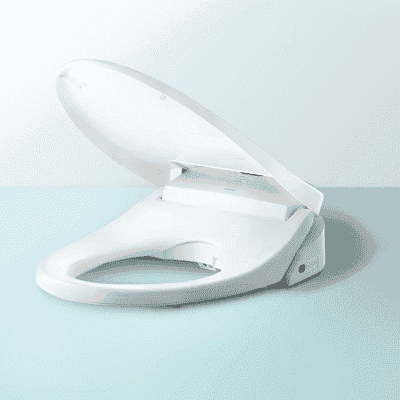

Design: Devon Gailey | Product Imagery: Kohler Puretide Manual Bidet & Toto C200 Electronic Bidet
As Americans seek more environmentally-friendly approaches to their homes and hygiene, bidets have grown in popularity. Recent toilet paper shortages have also convinced more users to opt for a different approach. Looking to make your bathroom more sustainable? Our guide will show you everything you need to know about bidet attachments and seats for your home.
Even if you’ve never actually used a bidet, you probably know what they are; and if you’ve ever traveled to Europe or Japan, you may have encountered one. But for those who don’t know, a bidet is essentially a device that uses a stream of water to help you clean instead of toilet paper. Bidets can sometimes be stand-alone devices, but in other instances, they are attachments to existing toilet seats.
If you’re interested in getting a bidet in your home, there are a number of standout bidet seats and attachments on the market today. We’ll walk you through just a few of the most popular options, highlighting some of the best buys in the bidet space.
Our Picks for the Best Bidets of 2021
Each product featured here has been independently selected by the writer. If you make a purchase using the links included, we may earn commission.
- Most Customizable Seat – Omigo Luxury Bidet Toilet Seat
- Best Water Options – Toto C200 Electronic Bidet
- Best Bidet Attachment – TUSHY Classic 3.0 Bidet Attachment
- Best Smart Bidet Seat – BioBidet Bliss BB-2000 Bidet Seat
- Most Affordable – LUXE Bidet Neo 120 Attachment
- Best for Comfort – Brondell Swash 1400 Bidet Seat
- Best Non-Electric Bidet Seat – Kohler Puretide Manual Bidet Toilet Seat
- Best for Accessibility – Coway Bidetmega 400E Bidet Seat
How We Reviewed Toilet Seat Attachments
To create our list of the best bidet seats and bidet attachments, we considered a few key categories for each product. For bidet seats, we looked for options that included heated seats, warm water reservoirs, self-cleaning wands, multiple nozzles, customization and adjustment options, ease-of-installation, and whether they offered an eco-mode or energy-saving setting. For bidet attachments, we looked for options with an affordable price, self-cleaning wands, easy installation, and whether they allow users to control or adjust water pressure and nozzle settings. Additionally, we compared brand reputation and the information they offered on how much the product could help reduce toilet paper waste in the environment. You can also read our individual reviews of Tushy, Omigo, and Toto bidets.
Here are the best bidet options for you to consider.
Omigo Luxury Bidet Toilet Seat

Omigo
For years, Omigo has been a leading name in luxury bidets and accessories. Their flagship product boasts hundreds of rave reviews, and a long list of exciting features. Some of the perks of choosing Omigo include:
- They offer various shapes, allowing you to pick the bidet that best matches your existing toilet bowl.
- Omigo offers a heated seat with adjustable temperature.
- An LED night light makes it easy for you to use your bidet even at night.
Why buy: You can customize your bidet experience by choosing from a range of nozzle positions and adjustable spray pressure settings, and separate rear and front nozzles are available.
Toto WASHLETT C200 Electronic Bidet

Toto USA
Toto is a company that’s well-established for its quality bidet products. The Toto C200 electric bidet seat comes with a number of advantages, and you can even create unique user profiles, ensuring the bidet remembers your preferences.
- Adjustable oscillating water options
- A built-in air dryer to assist you in personal hygiene.
- A self-cleaning wand automatically cleans up after each use.
Why buy: The Toto WASHLET C200 electric bidet features a deodorizer, heated seat, instant warm water reservoir, and a pre-mist cleaning function for added hygiene.
TUSHY Classic 3.0 Bidet Attachment

hellotushy
If you’re looking for an attachment rather than a full toilet seat, we recommend this model from TUSHY. The TUSHY Classic 3.0 is an especially great option for bidet shoppers on a budget from an eco-conscious brand.
- It’s made for easy installation, usually taking no more than 10 minutes.
- This is one of the very best bidet attachments for under 0.
- Controls let you customize nozzle placement and water pressure.
Why buy: Tushy claims their non-electric bidet attachment can reduce your toilet paper usage by 80%, saving trees and money.
BioBidet Bliss BB-2000 Bidet Seat

BioBidet
The BioBidet Bliss seat offers a number of advanced features including a comfort-adjustable heated seat with a remote control, adjustable warm air drying, and a patented vortex wash.
- Adjustable water temperature, water pressure, and heated seat.
- Three-in-one stainless steel nozzle design for a complete clean and feminine wash.
- Hybrid heating technology so you always have warm water.
Why buy: This electric bidet seat from BioBidet features an Energy Save Mode to reduce electricity usage as well as toilet paper usage.
LUXE Bidet Neo 120 Attachment

Luxe Bidet
LUXE offers affordable bidet options with a 100% satisfaction guarantee. If you’re looking to try out a basic bidet to see what it’s like, the LUXE Neo 120 attachment may be the perfect option. One thing to note, however, is that this model is non-electric and uses cold water.
- A self-cleaning, sanitary nozzle with guard helps promote cleanliness and hygiene.
- The LUXE bidet attachment installs easily and in minutes.
- 18-month warranty and 100% satisfaction guarantee.
Why buy: This is one of the most affordable bidet options out there, and is a great way to make your bathroom more sustainable.
Brondell Swash 1400 Bidet Toilet Seat

Brondell
Brondell is another company that offers top-of-the-line bidet toilet seats. The Swash 1400 features a heated seat, air dryer, replaceable deodorizer, and programmable user settings. Brondell also offers a non-electric Ecoseat series and a travel bidet.
- Seven different nozzle positions, and an ambient night light.
- The unit can be installed in under an hour, without any need to call a plumber.
- Front and rear nozzles allow for a complete cleaning experience.
Why buy: Brondell notes that 37 gallons of water are used to make one roll of toilet paper; that same amount of water is equivalent to 150 washes with their bidet seat.
Kohler Puretide Manual Bidet Toilet Seat

Kohler
The Kohler Puretide manual bidet seat is a simple, straightforward, and affordable product. It features a self-cleaning wand with adjustable water pressure and position.
- Sleek, low-profile design that doesn’t stand out.
- Manual-operated handle allows you to control water pressure without electricity.
- Quick-Attach hardware makes it easy to install in minutes.
Why buy: The Kohler Puretide is an affordable, non-electric bidet seat that makes it easy to reduce your environmental impact. It also features a very unobtrusive design.
Coway Bidetmega 400E Bidet Seat

Cowaymega
This electronic bidet seat from Coway includes a ton of features that make it an accessible option for every member of the family. The company’s unique i-wave Cleaning Technology is designed to provide a comfortable cleaning experience for every person.
- Wireless remote control with child-friendly controls and braille for visually-impaired users.
- Three-stage cleansing care system keeps the system hygienic.
- Adjustable water temperature, water pressure, direction, flow, and warm air dryer.
Why buy: Coway includes a lot of accessibility features in their bidet seats, as well as an eco-mode to reduce the energy consumption of the unit.
The Benefits of Using a Bidet
What are the top reasons for using a bidet? There are actually many benefits to consider.
Better Cleanliness
One reason why people love bidets is that water bidets help you get clean in ways that toilet paper just won’t. That’s because we all understand that a stream of water has greater cleaning power than paper or tissue. Additionally, some bidets have air drying and self-cleaning features to make them a more sanitary option.
Better for the Environment
Another reason to use a bidet is that it’s better for the environment than using toilet paper.
The U.S. accounts for a disproportionately high percentage of the world’s toilet paper use. A big reason for that? We don’t use bidets. But by making the switch, you can massively cut back on your own contributions to paper waste.
And while using a bidet does require you to use some water, but it’s actually quite a bit less water than what’s required to manufacture a single roll of toilet tissue.
Better for Your Wallet
Using a bidet can actually help you save quite a bit of money. The average bidet user reduces their annual toilet paper use by more than 75 percent, which for some families is quite a bit of money!
Plus, any time a major storm or a big snow is coming, folks head to the store to stock up on toilet paper. If you’ve got a bidet in your bathroom, you can skip the last-minute run to the store.
Additional Perks of a Bidet
The list of bidet benefits just goes on from there. Some additional advantages that bidet users can anticipate include:
- Bidets are comfortable and non-irritating to your skin
- Using a bidet can have particular benefits for women and expecting mothers, minimizing the risk of UTIs
- Bidets are very easy to use, including for those who have mobility issues
- By using a bidet, you will have a lower likelihood of clogged toilets and other expensive plumbing problems
- Bidets can be great for showing your kids how to use proper hygiene
Really, the list could go on and on. So with all of that said, let’s move on to the next question: What should you look for in a bidet?
What to Consider When Shopping for the Best bidet
In seeking a bidet seat or attachment, keep these shopping considerations in mind.
Electric Bidet vs. Non-Electric
An electric bidet seat is generally going to offer the most consistent and comfortable performance. By contrast, a mechanical bidet simply uses your home’s water pressure, which can be less reliable. With that said, a mechanical bidet will likely cost you less. If you’re hoping to spend under $300 on a bidet, a mechanical one is probably your only bet.
Heated Bidet vs. Non-Heated
Concerned about the shock of cold water from a bidet? You can invest in a bidet that uses warm water with temperature control instead. Keep in mind, though, that if it takes your hot water supply a few seconds to reach the bathroom sink, it will take just as long to reach the bidet.
Find a Self-Cleaning Bidet
Some bidets include a self-cleaning nozzle that can clean themselves between each use. Others will require you to manually clean the nozzle yourself. As you might imagine, self-cleaning bidets are a little more expensive, but much more convenient and hygienic.
Attachment vs. Seat
One of the biggest decisions to make is whether you’ll get a bidet attachment, or a full bidet seat. What’s the difference?
- A bidet attachment simply attaches to your current toilet seat. These often work just fine, but may not look as streamlined.
- A full bidet seat will be a bit more expensive, and potentially harder to install, but ultimately it’s a more compact approach.
Consider Multiple Nozzles
Many bidets will offer you a single nozzle, but some offer dual nozzles for more cleaning options. You’ll pay a little bit more for the twin nozzles, but for many bidet users, that will be money well spent.
Additional Features
High-end electric bidets come with a range of other features. Some of these extras might include:
- Pulsating water spray and oscillation options
- Warm air dryers
- Deodorizers
- “Smart” settings and user profiles with a control panel
Buying a Bidet FAQs
Q. Are bidets messy?
No, it’s actually very easy to adjust the pressure and positioning of a bidet nozzle, ensuring clean, precise use. Plus, many bidets include a self-cleaning function.
Q. What if I don’t have any room in my bathroom for a bidet?
One of the great things about bidet seats and attachments is that you don’t need any extra space. You can simply install one of these units onto your existing toilet.
Q. Are bidets primarily for women?
While bidets do offer special feminine hygiene benefits, they also help men remain clean and sanitary, without the need to use a bunch of toilet paper. Bidets are great for women, but they certainly aren’t just for women.
Q. Should I use soap with my bidet?
No! Regularly using soap in sensitive areas can actually cause irritation. Warm water is all that’s required for your bidet to offer its full, sanitary effects.
Q. Will I need a plumber to install my bidet?
All of the seats and attachments listed here are very easy to self-install and should not require you to call a plumber.
Choose the Bidet that’s Right for You and the Environment
Bidets are surging in popularity as more and more people discover the hygienic and environmental benefits. There’s never been a better time to try one out and enjoy the unique benefits for yourself. Use this guide to find the bidet that’s right for your comfort preferences and your budget to reduce your impact on the planet.
Josh Hurst is a journalist, critic, and essayist. He lives in Knoxville, TN, with his wife and three sons. He covers natural health, nutrition, supplements, and clean energy. His writing has appeared in Health, Shape, and Remedy Review.

 233k
233k  41k
41k  Subscribe
Subscribe 